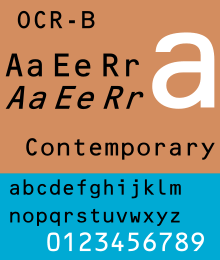OCR-B
|
| |
| Category | Sans-serif |
|---|---|
| Designer(s) | Adrian Frutiger |
| Date created | 1968 |
 | |
| Sample | |
OCR-B is a monospace font developed in 1968 by Adrian Frutiger for Monotype by following the European Computer Manufacturer's Association standard. Its function was to facilitate the optical character recognition operations by specific electronic devices, originally for financial and bank-oriented uses. It was accepted as the world standard in 1973.[1] It follows the ISO 1073/II-1976 (E) standard, refined in 1979 ("letterpress" design, size I). It includes all ASCII symbols, and other symbols included for the bank environment. It is widely used for the human readable digits in UPC / EAN barcodes. It is also used for machine-readable passports.[2] It shares that purpose with OCR-A, but it is easier for the human eye and brain to read and it has a less technical look.
Notes
- ↑ Frutiger, Adrian. Type. Sign. Symbol. ABC Verlag, Zurich, 1980. p. 50
- ↑ "Microsoft Word - Doc.9303.Part.03.7th.Edition.alltext.en.docx - 9303_p3_cons_en.pdf" (PDF). Doc 9303: Machine Readable Travel Documents, Part 3: Specifications Common to all MRTDs (Seventh ed.). International Civil Aviation Organization. 2015. p. 25. ISBN 978-92-9249-792-7. Retrieved 2016-03-03.
External links
-
 Media related to OCR-B at Wikimedia Commons
Media related to OCR-B at Wikimedia Commons - ISO Web-page where possible to buy the copy of the standard
- Web-page where possible to download a free version of OCR-B
- linotype.com web-page on OCR-B
- Article about OCR font on wordpress.com